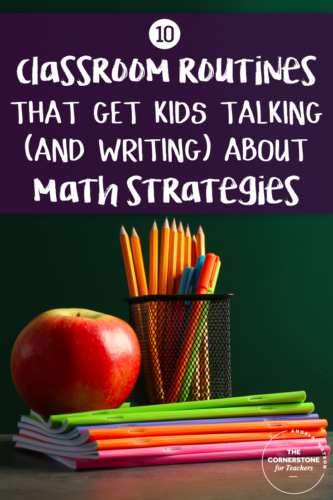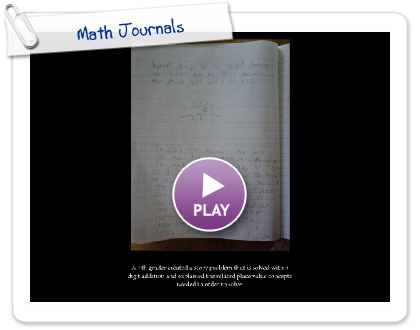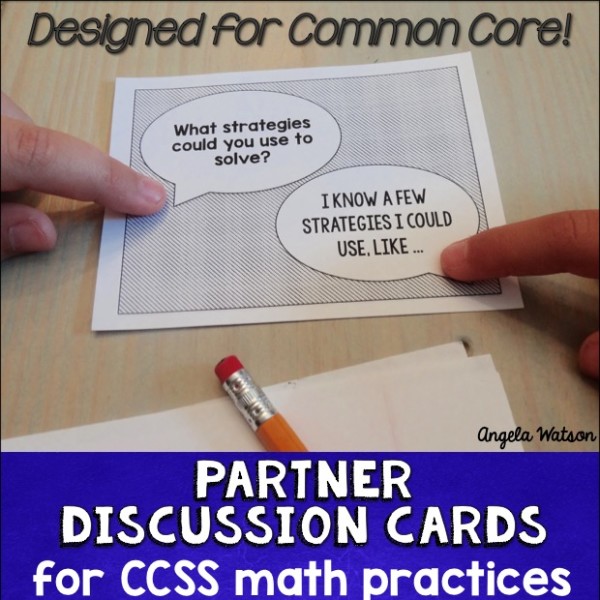Most kids find it challenging to explain how they solve math problems and to put what they know about math into words. These ten simple classroom routines can help make math talk a regular part of your day:
1) Start your math block with a strategizing session instead of a traditional warm-up problem.
Rather than having students solve a math problem on their own, have them jot down notes about how they would solve the problem, then pair up with a neighbor to discuss and compare their strategies. When you’re ready to bring the whole class together for a discussion, have a few pairs of students share how they’d solve, and invite students to test out their strategies.

2) Occasionally ask students to discuss strategies without actually solving the problem.
Present the math problem and ask students to explain (either orally or in writing) what operation they think they should use (and why), what steps they would take to solve the problem, or which tools could be helpful in solving. This shows students that there’s more to math than just finding the right answer: understanding HOW to solve and why a strategy works (or doesn’t work) is important, too.
3) Discuss math practices instead of just how a student arrived at an answer.
This can be tricky, so I created over 100 question stems for math practices to help you begin those conversations, as well as a reflection prompt that helps students think holistically about how they used all 8 math practices during a given activity. The prompts go beyond asking students to explain how they arrived at an answer: they require students to reflect on strong math practices and how those practices helped them approach the problem in a systematic, logical way. The prompts also help students reflect on their plan for solving, what happened when they noticed their plan was or wasn’t working, how math tools assisted them, patterns they noticed, strategies they used for checking their work, and how they could prove their answer is correct. Click the images below to download a free preview.

4) Bring creativity into problem solving.
Many kids who dislike math are frustrated that there’s only one right (and often elusive) answer to a problem, and they don’t realize the tremendous amount of freedom and creativity that they have in choosing a problem-solving strategy. When a student explains how s/he arrived at an answer, ask the class, “Does anyone have a different way of solving?” Your enthusiasm for trying out different strategies will lead to students’ increased engagement and risk-taking—kids love to hear their teacher say, “Wow, I never thought to solve it that way! Good thinking!”
5) Have kids use math journals to reflect on their strategies and assess their own learning.
Math journals are one of the most powerful tools for having students put their knowledge into words and to shift kids’ focus from computation to problem solving and real-life application. Asking students to write about problem solving strategies on a daily or weekly basis gives you so much insight into their understandings and misconceptions. On the Math Journals page, you can learn more about how to easily manage and assess math journals and download free grade level-specific math journal prompts.

6) Have a go-to set of leading questions.
Some of my favorites are: What did you notice when solving this problem? What strategy did you use to get that answer? How do you know your answer is right? Are there any other ways we could solve this problem? These are questions that I ask so often that students can’t help but pick up on them and integrate them into their own conversations about math.

7) Push student thinking with good questioning techniques.
If you’re not sure where to begin, check out the discussion starters I created to help you facilitate conversations with and between students during problem solving. The PDF has over 150 questions organized into the following categories:
- Preparing to solve problems
- Stimulating students’ thinking
- Active listening
- Choosing strategies
- Analyzing strategies
- Responding when students get stuck
- Assisting students in talking to one another
- Building on student responses in group conversations
- Responding supportively to incorrect/incomplete answers
- Pushing student thinking on incorrect/incomplete answers
- Selecting and analyzing answers
- Summing up/reflecting on math work
When using the question stems and prompts during math problem solving activities, you can use just one or two questions and have students delve deeply into them through written reflections or oral discussions. Or, you might use many of the questions in a single lesson as you facilitate a discussion. Click here to download the item preview which includes 5 pages of tips for having math conversations about problem solving.
8) Use math partner games.
I like to have students explore math concepts through game play for 5-15 minutes every single day. It’s a great way to break up instruction during long math blocks or kick off shorter math blocks and prepare kids for the day’s lesson. I pair them up with a partner of similar ability and have them play an open-ended game that allows them to construct their own knowledge about whichever math skill we’re currently learning about. They have to discuss strategies with their partner throughout the game, and typically I give students a discussion prompt to use at the end, as well. And because all the students are playing games at the same time, I’m free to walk around the room and listen to/guide their conversations about math. Visit the Math Game Routines page to learn more about how I create, organize, and introduce the games to students.
9) Have students create videos or screencasts explaining their strategies.
Writing about strategies can be a long, tedious process for some kids, but using a free app like Show Me (or another program/app that lets kids record their voices and the screen) is fun, easy, and quick. Students simply solve the problem by writing on the iPad with their finger and narrate what they’re doing. Have students watch each other’s videos and compare/contrast their approaches, or give parents the link and encourage them to talk with their students about the strategies they saw their child model.
10) Have students create posters (digital or otherwise) that demonstrate all the different ways a problem can be solved, and refer to them often.
These can be large bulletin board displays that are added to throughout the year, or something that students create individually and keep in their math notebooks or journals. As you introduce a skill (such as 2 digit addition, multiplication, or dividing with remainders), have students start a chart or poster that lists the first strategy you teach, and then add more strategies as they’re taught (or even better, discovered by the kids themselves.)
What routines or activities do you use to help students discuss and write about math strategies? Please share your ideas in the comments!
My Favorite Math Management Resources on Pinterest

Angela Watson
Founder and Writer
Discussion
Leave a Reply
OR

Join our
community
of educators
If you are a teacher who is interested in contributing to the Truth for Teachers website, please click here for more information.

















This is excellent! I shared it with my principal to pass onto my friends at school. I think they’ will find it very helpful AND it will validate what they’re already doing. Bonus!
Thanks so much, Colleen! So glad you found the info helpful.
Angela –
Did you ever teach at an America’s Choice school in NYC?
You look so familiar, I thought we may have met at a school or
at an AC conference.
Hi, Donna! No, I haven’t, but I’ve done PD in a lot of schools in the city. It’s definitely possible that we’ve crossed paths someplace! All the best to you!
YES YES YES! To all of it! This is why I LOVE teaching math…you and I are kindred spirits! For those who are looking for a great way to dip their toes in the water of increasing mathematical discourse in their classroom, I cannot recommend highly enough incorporating “number talks”. Watch the students’ engagement and understanding soar! Thanks for a great post!
Hi! I really enjoyed these tips. I love the stems as well. My district is big into math talk moves and I wish there were some kind of good resources to find word problems or activities to use when starting out the math block with math talks. Any suggestions?
I enjoyed everything you’ve said about Math talks and know that the Show Me app you mentioned would be a great tool for my classroom, but I can’t find it in the App Store. Is it found through a different name? Thanks for all your great ideas.